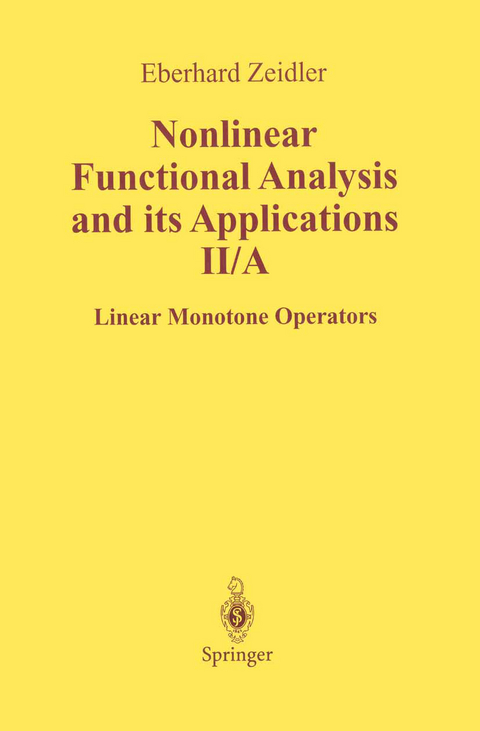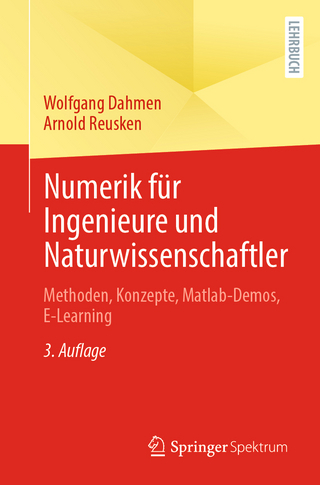
Nonlinear Functional Analysis and Its Applications
Springer-Verlag New York Inc.
978-0-387-96802-5 (ISBN)
- Titel erscheint in neuer Auflage
- Artikel merken
to the Subject.- 18 Variational Problems, the Ritz Method, and the Idea of Orthogonality.- §18.1. The Space C0?(G) and the Variational Lemma.- §18.2. Integration by Parts.- §18.3. The First Boundary Value Problem and the Ritz Method.- §18.4. The Second and Third Boundary Value Problems and the Ritz Method.- §18.5. Eigenvalue Problems and the Ritz Method.- §18.6. The Hölder Inequality and its Applications.- §18.7. The History of the Dirichlet Principle and Monotone Operators.- §18.8. The Main Theorem on Quadratic Minimum Problems.- §18.9. The Inequality of Poincaré-Friedrichs.- §18.10. The Functional Analytic Justification of the Dirichlet Principle.- §18.11. The Perpendicular Principle, the Riesz Theorem, and the Main Theorem on Linear Monotone Operators.- §18.12. The Extension Principle and the Completion Principle.- §18.13. Proper Subregions.- §18.14. The Smoothing Principle.- §18.15. The Idea of the Regularity of Generalized Solutions and the Lemma of Weyl.- §18.16. The Localization Principle.- §18.17. Convex Variational Problems, Elliptic Differential Equations, and Monotonicity.- §18.18. The General Euler-Lagrange Equations.- §18.19. The Historical Development of the 19th and 20th Problems of Hilbert and Monotone Operators.- §18.20. Sufficient Conditions for Local and Global Minima and Locally Monotone Operators.- 19 The Galerkin Method for Differential and Integral Equations, the Friedrichs Extension, and the Idea of Self-Adjointness.- §19.1. Elliptic Differential Equations and the Galerkin Method.- §19.2. Parabolic Differential Equations and the Galerkin Method.- §19.3. Hyperbolic Differential Equations and the Galerkin Method.- §19.4. Integral Equations and the Galerkin Method.- §19.5. Complete Orthonormal Systems and Abstract Fourier Series.- §19.6. Eigenvalues of Compact Symmetric Operators (Hilbert-Schmidt Theory).- §19.7. Proof of Theorem 19.B.- §19.8. Self-Adjoint Operators.- §19.9. The Friedrichs Extension of Symmetric Operators.- §19.10. Proof of Theorem 19.C.- §19.11. Application to the Poisson Equation.- §19.12. Application to the Eigenvalue Problem for the Laplace Equation.- §19.13. The Inequality of Poincaré and the Compactness Theorem of Rellich.- §19.14. Functions of Self-Adjoint Operators.- §19.15. Application to the Heat Equation.- §19.16. Application to the Wave Equation.- §19.17. Semigroups and Propagators, and Their Physical Relevance.- §19.18. Main Theorem on Abstract Linear Parabolic Equations.- §19.19. Proof of Theorem 19.D.- §19.20. Monotone Operators and the Main Theorem on Linear Nonexpansive Semigroups.- §19.21. The Main Theorem on One-Parameter Unitary Groups.- §19.22. Proof of Theorem 19.E.- §19.23. Abstract Semilinear Hyperbolic Equations.- §19.24. Application to Semilinear Wave Equations.- §19.25. The Semilinear Schrödinger Equation.- §19.26. Abstract Semilinear Parabolic Equations, Fractional Powers of Operators, and Abstract Sobolev Spaces.- §19.27. Application to Semilinear Parabolic Equations.- §19.28. Proof of Theorem 19.I.- §19.29. Five General Uniqueness Principles and Monotone Operators.- §19.30. A General Existence Principle and Linear Monotone Operators.- 20 Difference Methods and Stability.- §20.1. Consistency, Stability, and Convergence.- §20.2. Approximation of Differential Quotients.- §20.3. Application to Boundary Value Problems for Ordinary Differential Equations.- §20.4. Application to Parabolic Differential Equations.- §20.5. Application to Elliptic Differential Equations.- §20.6. The Equivalence Between Stability and Convergence.- §20.7. The Equivalence Theorem of Lax for Evolution Equations.- Linear Monotone Problems.- 21 Auxiliary Tools and the Convergence of the Galerkin Method for Linear Operator Equations.- §21.1. Generalized Derivatives.- §21.2. Sobolev Spaces.- §21.3. The Sobolev Embedding Theorems.- §21.4. Proof of the Sobolev Embedding Theorems.- §21.5. Duality in B-Spaces.- §21.6. Duality in H-Spaces.- §21.7. The Idea of Weak Convergence.- §21.8. The Idea of Weak* Convergence.- §21.9. Linear Operators.- §21.10. Bilinear Forms.- §21.11. Application to Embeddings.- §21.12. Projection Operators.- §21.13. Bases and Galerkin Schemes.- §21.14. Application to Finite Elements.- §21.15. Riesz-Schauder Theory and Abstract Fredholm Alternatives.- §21.16. The Main Theorem on the Approximation-Solvability of Linear Operator Equations, and the Convergence of the Galerkin Method.- §21.17. Interpolation Inequalities and a Convergence Trick.- §21.18. Application to the Refined Banach Fixed-Point Theorem and the Convergence of Iteration Methods.- §21.19. The Gagliardo-Nirenberg Inequalities.- §21.20. The Strategy of the Fourier Transform for Sobolev Spaces.- §21.21. Banach Algebras and Sobolev Spaces.- §21.22. Moser-Type Calculus Inequalities.- §21.23. Weakly Sequentially Continuous Nonlinear Operators on Sobolev Spaces.- 22 Hilbert Space Methods and Linear Elliptic Differential Equations.- §22.1. Main Theorem on Quadratic Minimum Problems and the Ritz Method.- §22.2. Application to Boundary Value Problems.- §22.3. The Method of Orthogonal Projection, Duality, and a posteriori Error Estimates for the Ritz Method.- §22.4. Application to Boundary Value Problems.- §22.5. Main Theorem on Linear Strongly Monotone Operators and the Galerkin Method.- §22.6. Application to Boundary Value Problems.- §22.7. Compact Perturbations of Strongly Monotone Operators, Fredholm Alternatives, and the Galerkin Method.- §22.8. Application to Integral Equations.- §22.9. Application to Bilinear Forms.- §22.10. Application to Boundary Value Problems.- §22.11. Eigenvalue Problems and the Ritz Method.- §22.12. Application to Bilinear Forms.- §22.13. Application to Boundary-Eigenvalue Problems.- §22.14. Gårding Forms.- §22.15. The Gårding Inequality for Elliptic Equations.- §22.16. The Main Theorems on Gårding Forms.- §22.17. Application to Strongly Elliptic Differential Equations of Order 2m.- §22.18. Difference Approximations.- §22.19. Interior Regularity of Generalized Solutions.- §22.20. Proof of Theorem 22.H.- §22.21. Regularity of Generalized Solutions up to the Boundary.- §22.22. Proof of Theorem 22.I.- 23 Hilbert Space Methods and Linear Parabolic Differential Equations.- §23.1. Particularities in the Treatment of Parabolic Equations.- §23.2. The Lebesgue Space Lp(0, T; X) of Vector-Valued Functions.- §23.3. The Dual Space to Lp(0, T; X).- §23.4. Evolution Triples.- §23.5. Generalized Derivatives.- §23.6. The Sobolev Space WP1 (0, T; V, H).- §23.7. Main Theorem on First-Order Linear Evolution Equations and the Galerkin Method.- §23.8. Application to Parabolic Differential Equations.- §23.9. Proof of the Main Theorem.- 24 Hilbert Space Methods and Linear Hyperbolic Differential Equations.- §24.1. Main Theorem on Second-Order Linear Evolution Equations and the Galerkin Method.- §24.2. Application to Hyperbolic Differential Equations.- §24.3. Proof of the Main Theorem.
| Erscheint lt. Verlag | 11.12.1989 |
|---|---|
| Übersetzer | E. Zeidler, Leo F. Boron |
| Zusatzinfo | 5 Tables, black and white; XVIII, 467 p. |
| Verlagsort | New York, NY |
| Sprache | englisch |
| Maße | 155 x 235 mm |
| Gewicht | 1900 g |
| Themenwelt | Mathematik / Informatik ► Mathematik ► Analysis |
| ISBN-10 | 0-387-96802-4 / 0387968024 |
| ISBN-13 | 978-0-387-96802-5 / 9780387968025 |
| Zustand | Neuware |
| Haben Sie eine Frage zum Produkt? |
aus dem Bereich



